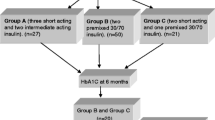Abstract
During a period of 17 months, 15 C-peptide negative insulin-dependent diabetic children (14±4 years old) have used an injector pen (Novopen, Novo, France) to deliver soluble insulin before meals, in association with an insulin syringe for long-acting insulin administration at bedtime. Despite frequent daily insulin injections (4–5) and blood glucose determinations (3–4), long-term patient acceptability as well as cutaneous tolerance were excellent. Novopen was experienced as a progress (100%) which made a multiple injection regimen acceptable and provided an improvement in the quality of life (77%), as recorded by questionnaires answered at the end of the study. Twelve out of 15 patients chose to continue this treatment. No significant change in glycaemic control was observed in the group as a whole. An improvement in glycosylated haemoglobin (HbA 1c) was noticed only in the previously “poorly-controlled” children (n=8) with initial HbA1c>7%. In this group HbA1c decreased from 8.4±1.8% (mean±SD), to 7.3±1.2% (P<0.05) within the first 6 months of Novopen therapy. No increment of hypoglycaemia frequency and mean daily insulin requirements was observed. No ketoacidotic episode was noticed during the study. In conclusion, in this group of diabetic children, no long term metabolic improvement was obtained, despite excellent acceptability of the multiple injection regimen with Novopen.
Similar content being viewed by others
Abbreviations
- CBG:
-
capillary blood glucose
- CSII:
-
continuous subcutaneous insulin infusion
- HbA1c:
-
glycosylated haemoglobin
- IDDM:
-
insulin-dependent diabetes mellitus
- MSII:
-
multiple subcutaneous insulin injections
References
Back JF, Nielsen OH, Pedersen O, Beck-Nielsen H (1987) Multiple insulin injections using a pen injector versus insulin pump treatment in young diabetic patients. Diabetes Res 6:155–158
Berger AS, Saurbrey N, Kühl C, Villumsen J (1985) Clinical experience with a new device that will simplify insulin injections. Diabetes Care 8:73–76
Brink SJ, Stewart C (1986) Insulin pump treatment in insulin-dependent diabetes mellitus children, adolescents and young adults. JAMA 255:617–621
Chiasson JL, Ducros F, Poliquin-Hamet M, Lopez D, Lecavalier L, Hamet P (1984) Continuous subcutaneous insulin infusion (Mill-Hill infuser) versus multiple injections (Medi-Jector) in the treatment of insulin-dependent diabetes mellitus and the effect of metabolic control on microangiopathy. Diabetes Care 7:331–337
Davies AG, Price DA, Houlton CA, Buru JL, Fielding BA, Postletwhaite RJ (1984) Continuous subcutaneous insulin infusion in diabetes mellitus. A year's prospective trial. Arch Dis Child 59:1027–1033
Greene SA, Smith MA, Baum JD (1983) Clinical application of insulin pumps in the management of insulin dependent diabetes. Arch Dis Child 58:578–581
Author information
Authors and Affiliations
Rights and permissions
About this article
Cite this article
Tubiana-Rufi, N., Levy-Marchal, C., Mugnier, E. et al. Long term feasibility of multiple daily injections with insulin pens in children and adolescents with diabetes. Eur J Pediatr 149, 80–83 (1989). https://doi.org/10.1007/BF01995851
Issue Date:
DOI: https://doi.org/10.1007/BF01995851




